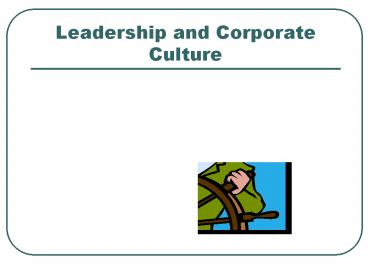Leadership and Corporate Culture - PowerPoint PPT Presentation
Title:
Leadership and Corporate Culture
Description:
Leadership and Corporate Culture What is Leadership? Why is the Leader Important to An Organization? Levels of Leadership (Jim Collins, HBR, Jan. 2001) Highly capable ... – PowerPoint PPT presentation
Number of Views:556
Avg rating:3.0/5.0
Title: Leadership and Corporate Culture
1
Leadership and Corporate Culture
2
What is Leadership?
3
Why is the Leader Important to An Organization?
4
Levels of Leadership (Jim Collins, HBR, Jan.
2001)
- Highly capable individual
- Contributing team member
- Competent manager
- Effective leader catalyzes commitment to and
vigorous pursuit of a clear compelling vision,
stimulate high performance - Executive builds enduring greatness through
humility and professional wills
5
What are the Leadership Traits of Highly
Productive Organizations?
6
Leadership Development
- Leadership skills
- Management skills
- Communication skills
- Problem identification and solving skills
- Strategic development and execution skills
7
Leadership Strategies for Productivity
Improvement?
8
Leadership Commitment(Donald N. Sull, HBR, June
2003)
- Strategic frame
- Resources
- Processes
- Relationships
- Values
9
What Is Corporate Culture?
10
Definition of Culture
- Observable
- Artifacts and behaviors symbols, awards,
stories, heroes, slogans, ceremonies - Not Observable
- Values and beliefs
- Underlying assumptions
11
Purpose of Culture
- Organizational socialization
- Formal
- Informal
- Behavioral conformity
- Values and beliefs
- Behaviors
12
Dominant Orientation of Culture
- Market and financial-oriented defined in terms
of customers needs and financial performance - Materials- or product-oriented defined in terms
of the material it works with or the product it
makes - Technology-oriented defined in terms of the
technology that it uses - People-oriented defined in terms of how
employees are hired and treated
13
Best Values
- They have a grab-you-by-the heart quality
- They often precede and drive strategy
- They are put into place by living them
- They enable people at every level to become
leaders - They are consistent with the everyday values to
which most people aspire - They get managed as proactively as strategies,
plans, and budgets.
Robert Waterman, What America Does Right
14
What Are the Foundations of A Productivity-Focuse
d Culture?
15
Strategies to Create A Culture for Productivity
Improvement?
16
Managerial Culture Reinforcement Actions
- The behaviors managers measure and control
- Managers reactions to crises
- Modeling and coaching of expected behaviors
- Criteria for allocation of rewards
- Criteria for selection, promotion, and
termination of employees
17
Actions to Change Culture
- 1. Change peoples behaviors through reward,
- training, policies, etc.
- 2. Justify the new behaviors using new culture
- artifacts stories, symbols, rituals,
heroes. - 3. Communicate the new artifacts widely and
- consistently
- 4. Hire new employees who match the new culture
- 5. Remove employees whose behaviors deviate
- from the new culture values
18
Making Radical Change
- Anticipating,
- exploiting, and
- creating
- breakpoints
Paul Strebel, Breakpoints
19
Organizational Transformation Process (John
Kotter, Leading Change)
- 1. Establishing a sense of urgency
- 2. Creating the guiding coalition
- 3. Developing a vision and strategy
- 4. Communicating the change visions
- 5. Empowering employees for broad-based action
- 6. Generating short-term wins
- 7. Consolidating gains and producing more change
- 8. Anchoring new approaches in the culture
20
Strategies to Help Employees Embrace A Change
Initiative?
- Senior Managers
- Middle Managers
- Front-Line Staff
21
Organizational Design for Productivity Improvement
- Simplify
- Reduce the number of layers
- Reduce and eliminate bureaucracy
- Empower employees
- Promote cooperation and information sharing
- Teamwork
- Cross-functional teams
- Knowledge and information sharing systems































